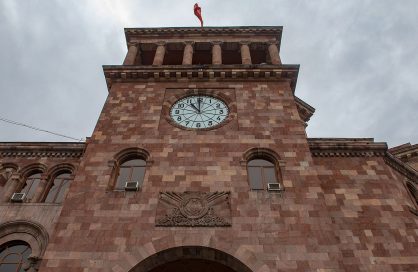Biden Can Help Armenia and Azerbaijan Make Peace. Here’s How
POLITICS
01.04.2021 | 21:55
Former US Ambassador to the OSCE Daniel Bayer (2013-2017) published an article in Foreign Policy, presenting how President Joe Biden can help Armenia and Azerbaijan achieve peace.
The first 100 days are not even over, and the Biden administration’s national security and the foreign-policy team has already dealt with major fires around the world—from the Saudi-backed war in Yemen to a military coup and brutal crackdown in Myanmar to calibrating the relationship with a bristling China.
Late last year, a war broke out between Armenia and Azerbaijan, and although the bullets and bombs have stopped, for now, the underlying conflict has not ended. It is an example of the kind of problem that slips out of the headlines and, therefore, away from the firefighters’ view. That’s too bad—not only because the smoldering embers could ignite further violence and human misery but also because firefighting is about preventing destruction, not about construction. If all one does is put out fires, one never builds anything. In other words, moments of relative calm, however tense and enduring the challenges might be, often present the opportunities—however difficult—for actual progress.
Though its roots go back further (they always do), in its contemporary incarnation the conflict between Armenia and Azerbaijan erupted three decades ago, as ripples of the Soviet Union’s slow-motion collapse began radiating outward from its epicenter in Moscow.
Until a new wide-scale war broke out in September 2020, the conflict over the status of the majority-Armenian region of Nagorno-Karabakh and adjacent territories had been mostly frozen since 1994, when a Russian-brokered cease-fire ended several years of war that killed thousands of people and displaced more than a million in the two former Soviet republics. Since 1997, the United States, Russia, and France, as co-chairs of the Minsk Group at the Organization for Security and Cooperation in Europe (OSCE), have been charged with facilitating negotiations toward a lasting resolution.
But in recent years, diplomacy faltered, and outbreaks of violence along the line of contact became more frequent, including a four-day conflagration in 2016. The 1994 agreement left Armenia in de facto control not only of Nagorno-Karabakh, a majority-Armenian region that had been part of Azerbaijan in the Soviet Union but also of adjacent Azerbaijani territories—and it was signed in part because of Azerbaijan’s fear at the time that Armenian troops might make further gains, including attacking Azerbaijan’s second-largest city, Ganja. But in the intervening decades, Azerbaijan’s oil money combined with military, intelligence, and training support from Turkey—and Armenia’s relative poverty and dependence on Russia—created a situation where the party dissatisfied with the status quo, Azerbaijan, had accumulated significant advantages in military power. This loaded the spring for renewed conflict, and the failure of the parties to negotiate effectively—and of the international community to pressure and incentivize them to do so—released the spring in the new war that broke out last year.
This time, roles were reversed as Azerbaijan reclaimed territory adjoining Nagorno-Karabakh and wrested control of a significant portion of Nagorno-Karabakh itself before the parties signed another Russian-brokered cease-fire late in the night of Nov. 9, 2020. Notably, that agreement provides for 2,000 Russian peacekeepers to be deployed along a new line of contact and in the corridor connecting Nagorno-Karabakh to Armenia proper—a step that worries many who have witnessed how in Georgia and Moldova, two other former Soviet republics, Russian so-called peacekeepers have undermined sovereignty rather than reinforced it.
The new status quo is unlikely to change in the near term, nor do the two parties seem willing to move forward constructively. And the Nov. 9 agreement is only a cease-fire, not a peace accord. Furthermore, the deep involvement of ambiguous objectives of Russia and Turkey make things even more complicated, and the situation on the ground is already a morass of sensitive transit routes and mountainous terrain. Looking at maps of the conflict area can actually be confusing rather than clarifying.
Today Azerbaijan, though drunk with victory, remains a brittle and repressive petrostate held back by official corruption and economic stagnation. Armenia’s democratic reforms, a source of hope after the 2018 political transition, are—like its prime minister, Nikol Pashinyan—on the ropes, as weak institutions and a disheartened populace prove vulnerable to Russian disinformation, corruption, and anti-Western narratives. Though an improvement over his predecessors, Pashinyan has proved an unsteady steward of Armenia’s democratic transformation. This month, he called for snap elections in a bid to escape the political crisis precipitated by anger over Armenia’s defeat. Either way, Armenia is likely to remain painfully dependent on Moscow. And leaders in both Baku and Yerevan have prepared their populations for war for more than a generation and have done little to lay the groundwork for peace. Against this backdrop, senior officials in the Biden administration might well argue internally that they should keep an eye on the situation but focus their energies elsewhere—and not attempt to play a leading role diplomatically.
This would be a mistake. Instead, the new U.S. administration should see the South Caucasus region as an opportunity to demonstrate the value of serious U.S. engagement and use it as an example of President Joe Biden’s commitment to a pro-democracy foreign policy centered on universal values and human rights. This is not to suggest that a dramatic breakthrough is obviously in reach; there is plenty of reason for sober analysis and skepticism about outcomes. But without energetic U.S. diplomacy, there is significantly less hope for progress.


































































